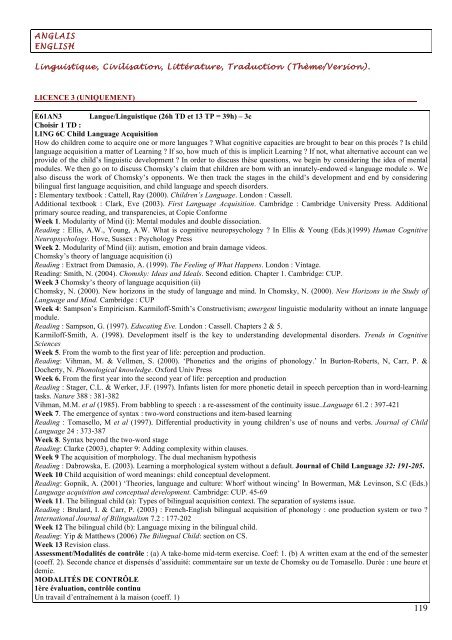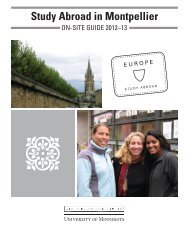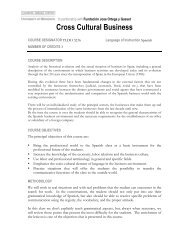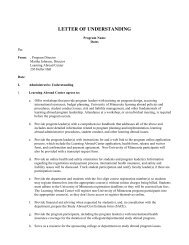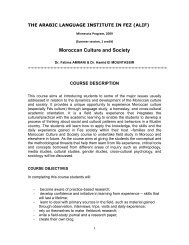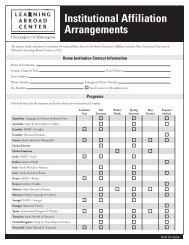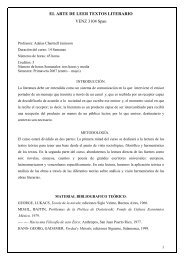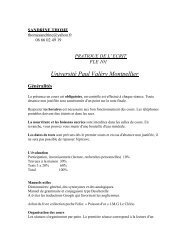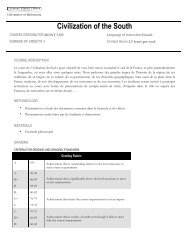04 67 79 15 42 2012-2013 SEMEST - University of Minnesota
04 67 79 15 42 2012-2013 SEMEST - University of Minnesota
04 67 79 15 42 2012-2013 SEMEST - University of Minnesota
You also want an ePaper? Increase the reach of your titles
YUMPU automatically turns print PDFs into web optimized ePapers that Google loves.
ANGLAIS<br />
ENGLISH<br />
Linguistique, Civilisation, Littérature, Traduction (Thème/Version).<br />
LICENCE 3 (UNIQUEMENT)<br />
E61AN3 Langue/Linguistique (26h TD et 13 TP = 39h) – 3c<br />
Choisir 1 TD :<br />
LING 6C Child Language Acquisition<br />
How do children come to acquire one or more languages ? What cognitive capacities are brought to bear on this procès ? Is child<br />
language acquisition a matter <strong>of</strong> Learning ? If so, how much <strong>of</strong> this is implicit Learning ? If not, what alternative account can we<br />
provide <strong>of</strong> the child’s linguistic development ? In order to discuss thèse questions, we begin by considering the idea <strong>of</strong> mental<br />
modules. We then go on to discuss Chomsky’s claim that children are born with an innately-endowed « language module ». We<br />
also discuss the work <strong>of</strong> Chomsky’s opponents. We then track the stages in the child’s development and end by considering<br />
bilingual first language acquisition, and child language and speech disorders.<br />
: Elementary textbook : Cattell, Ray (2000). Children’s Language. London : Cassell.<br />
Additional textbook : Clark, Eve (2003). First Language Acquisition. Cambridge : Cambridge <strong>University</strong> Press. Additional<br />
primary source reading, and transparencies, at Copie Conforme<br />
Week 1. Modularity <strong>of</strong> Mind (i): Mental modules and double dissociation.<br />
Reading : Ellis, A.W., Young, A.W. What is cognitive neuropsychology ? In Ellis & Young (Eds.)(1999) Human Cognitive<br />
Neuropsychology. Hove, Sussex : Psychology Press<br />
Week 2. Modularity <strong>of</strong> Mind (ii): autism, emotion and brain damage videos.<br />
Chomsky’s theory <strong>of</strong> language acquisition (i)<br />
Reading : Extract from Damasio, A. (1999). The Feeling <strong>of</strong> What Happens. London : Vintage.<br />
Reading: Smith, N. (20<strong>04</strong>). Chomsky: Ideas and Ideals. Second edition. Chapter 1. Cambridge: CUP.<br />
Week 3 Chomsky’s theory <strong>of</strong> language acquisition (ii)<br />
Chomsky, N. (2000). New horizons in the study <strong>of</strong> language and mind. In Chomsky, N. (2000). New Horizons in the Study <strong>of</strong><br />
Language and Mind. Cambridge : CUP<br />
Week 4: Sampson’s Empiricism. Karmil<strong>of</strong>f-Smith’s Constructivism; emergent linguistic modularity without an innate language<br />
module.<br />
Reading : Sampson, G. (1997). Educating Eve. London : Cassell. Chapters 2 & 5.<br />
Karmil<strong>of</strong>f-Smith, A. (1998). Development itself is the key to understanding developmental disorders. Trends in Cognitive<br />
Sciences<br />
Week 5. From the womb to the first year <strong>of</strong> life: perception and production.<br />
Reading: Vihman, M. & Vellmen, S. (2000). ‘Phonetics and the origins <strong>of</strong> phonology.’ In Burton-Roberts, N, Carr, P. &<br />
Docherty, N. Phonological knowledge. Oxford Univ Press<br />
Week 6. From the first year into the second year <strong>of</strong> life: perception and production<br />
Reading : Stager, C.L. & Werker, J.F. (1997). Infants listen for more phonetic detail in speech perception than in word-learning<br />
tasks. Nature 388 : 381-382<br />
Vihman, M.M. et al (1985). From babbling to speech : a re-assessment <strong>of</strong> the continuity issue..Language 61.2 : 397-<strong>42</strong>1<br />
Week 7. The emergence <strong>of</strong> syntax : two-word constructions and item-based learning<br />
Reading : Tomasello, M et al (1997). Differential productivity in young children’s use <strong>of</strong> nouns and verbs. Journal <strong>of</strong> Child<br />
Language 24 : 373-387<br />
Week 8. Syntax beyond the two-word stage<br />
Reading: Clarke (2003), chapter 9: Adding complexity within clauses.<br />
Week 9 The acquisition <strong>of</strong> morphology. The dual mechanism hypothesis<br />
Reading : Dabrowska, E. (2003). Learning a morphological system without a default. Journal <strong>of</strong> Child Language 32: 191-205.<br />
Week 10 Child acquisition <strong>of</strong> word meanings: child conceptual development.<br />
Reading: Gopnik, A. (2001) ‘Theories, language and culture: Whorf without wincing’ In Bowerman, M& Levinson, S.C (Eds.)<br />
Language acquisition and conceptual development. Cambridge: CUP. 45-69<br />
Week 11. The bilingual child (a): Types <strong>of</strong> bilingual acquisition context. The separation <strong>of</strong> systems issue.<br />
Reading : Brulard, I. & Carr, P. (2003) : French-English bilingual acquisition <strong>of</strong> phonology : one production system or two ?<br />
International Journal <strong>of</strong> Bilingualism 7.2 : 177-202<br />
Week 12 The bilingual child (b): Language mixing in the bilingual child.<br />
Reading: Yip & Matthews (2006) The Bilingual Child: section on CS.<br />
Week 13 Revision class.<br />
Assessment/Modalités de contrôle : (a) A take-home mid-term exercise. Coef: 1. (b) A written exam at the end <strong>of</strong> the semester<br />
(coeff. 2). Seconde chance et dispensés d’assiduité: commentaire sur un texte de Chomsky ou de Tomasello. Durée : une heure et<br />
demie.<br />
MODALITÉS DE CONTRÔLE<br />
1ère évaluation, contrôle continu<br />
Un travail d’entraînement à la maison (coeff. 1)<br />
119


